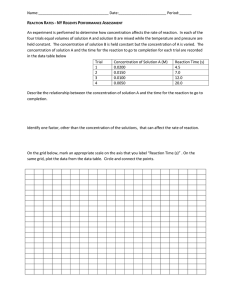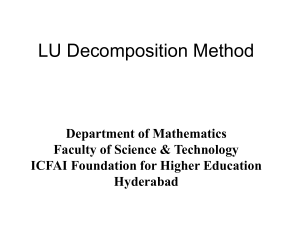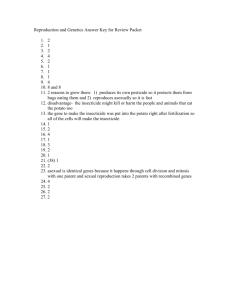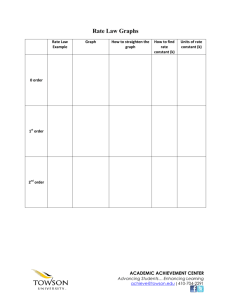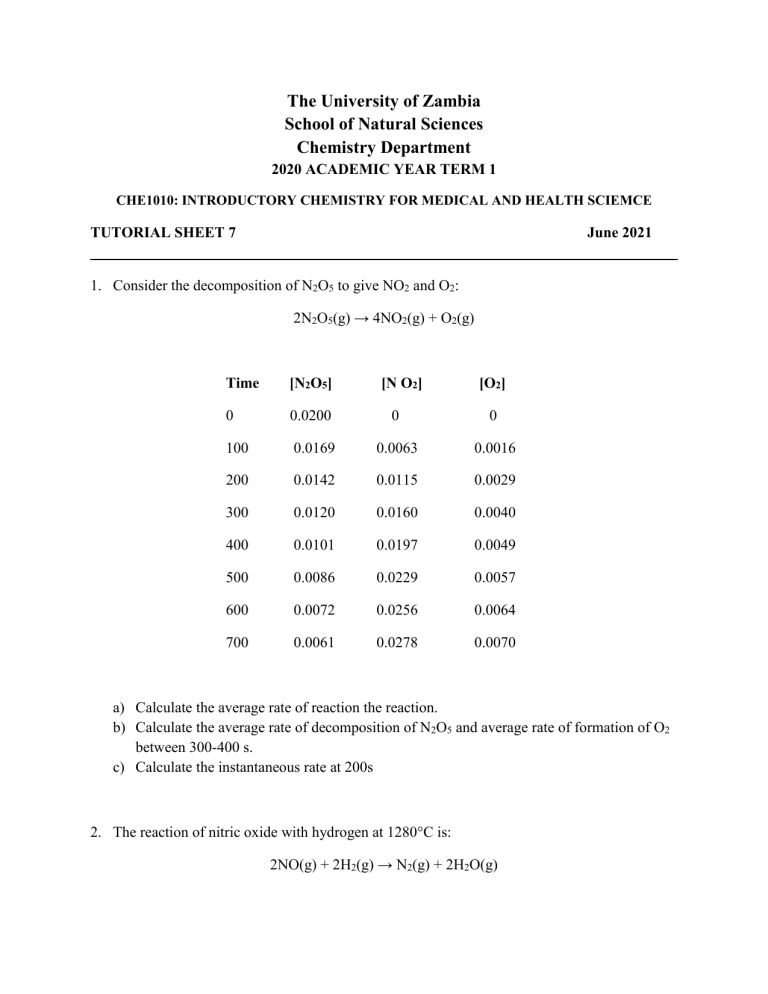
The University of Zambia School of Natural Sciences Chemistry Department 2020 ACADEMIC YEAR TERM 1 CHE1010: INTRODUCTORY CHEMISTRY FOR MEDICAL AND HEALTH SCIEMCE TUTORIAL SHEET 7 June 2021 1. Consider the decomposition of N2O5 to give NO2 and O2: 2N2O5(g) → 4NO2(g) + O2(g) Time [N2O5] [N O2] [O2] 0 0.0200 0 0 100 0.0169 0.0063 0.0016 200 0.0142 0.0115 0.0029 300 0.0120 0.0160 0.0040 400 0.0101 0.0197 0.0049 500 0.0086 0.0229 0.0057 600 0.0072 0.0256 0.0064 700 0.0061 0.0278 0.0070 a) Calculate the average rate of reaction the reaction. b) Calculate the average rate of decomposition of N2O5 and average rate of formation of O2 between 300-400 s. c) Calculate the instantaneous rate at 200s 2. The reaction of nitric oxide with hydrogen at 1280°C is: 2NO(g) + 2H2(g) → N2(g) + 2H2O(g) From the following data, determine the rate law and rate constant with its units. Exp. no [NO] (M) [H2] (M) Initial Rate (M min) 1 0.0100 0.0100 0.00600 2 0.0200 0.0300 0.144 3 0.0100 0.0200 0.0120 3. The rate of decomposition of azomethane (C2H6N2) was studied by monitoring the partial pressure of the reactant as a function of time. Determine the order of reaction and calculate the rate constant for the reaction. Time (s) 0 Pressure (mmHg) 284 100 220 150 193 200 170 250 150 4. A reaction believed to be either first or second order has a half-life of 20 s at the beginning of the reaction but a half-life of 40 s sometime later. What is the order of the reaction? 5. The decomposition of a certain insecticide in water follows first order kinetics with a rate constant of 1.45 yr-1 at 20 °C. A quantity of this insecticide is washed into Lake Kariba on May 1, 2021 leading to a concentration of 5.0 ×10-7 g/cm3. Assume that the average temperature of the lake is 20 °C. a) What will be the concentration of the insecticide on May 1, 2022? b) How long will it take for the concentration of the insecticide to decrease to 3.0 ×10-7 g/cm3? 6. If a reaction is second order in B and the concentration of B increased from 0.0850 M to 0.2975 M. Will the rate change and by what factor. 7. A fixed mass of marble is reacted with dilute hydrochloric acid at a constant temperature. Explain in brief, why the rate of the reaction is increased if the lumps of marble are reduced in size. 8. The following data were obtained for the reaction 2NO + O2→ 2NO2: Exp. no [NO]0 [O2]0 Initial rate, v0(mol L-1s-1 1 0.12 M 0.05 M 0.12 2 0.12 M 0.10 M 0.24 3 0.24 M 0.05 M 0.48 a) Write the rate law for the reaction. Explain your reasoning in arriving at your rate law (NO CALCULATIONS REQUIRED). b) What is the overall order of the reaction? c) Determine the value of the rate constant with its units. 9. The rate equation for the decomposition of a compound N has a rate constant with the unit s1 . The rate constant is 4.31 × 103 s-1 at 700 K and 1.78 × 104 s-1 at a temperature T. Use this information to deduce the overall order of reaction and whether temperature T is greater or smaller than 700 K.

